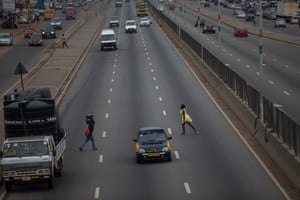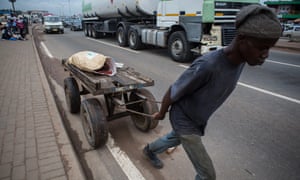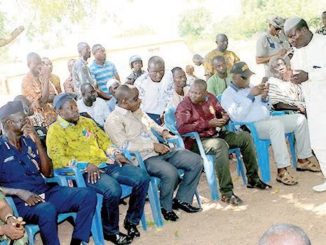Across the busy Adenta-Madina highway in Ghana’s capital, Accra, there loom six incomplete concrete footbridges. Unusable for their intended purpose, they currently serve as advertising hoarding for politicians and companies.
For well over a decade since the highway – but not its pedestrian bridges – was completed, residents of the city’s Adenta district have watched, horrified, as the traffic has grown worse and pedestrian fatalities have become more common, thanks both to reckless driving and the lack of safe crossing places.
Armed police were sent in to restore order; in the clashes that followed they were accused of using gunfire and brute force to subdue protesters – although police chief David Asante-Apeatu rejects these claims.
Angry residents say 195 lives have been lost on the road in the past year, but official police figures claim the total is significantly lower: 24, and 164 injuries. This discrepancy is due at least in part to low reporting rates for accidents and crime.

Ghana’s president, Nana Akufo-Addo, has blamed the lack of pedestrian infrastructure on former administrations. Following the latest fatality, which he described as an unnecessary loss, Akufo-Addo pledged to ensure work will resume on the footbridges. Meanwhile, police have been deployed to the highway to control traffic and prevent further deaths.
Ghana’s former roads and highways minister Alhaji Inusah Fuseini says the government is simply attempting to shift the blame.
“Before I left office the only safety mechanism left on the road was to complete the footbridges,” Fuseini told Rainbow Radio. “If the government had prioritised the project this wouldn’t have happened.”

Saul Billingsley, executive director of the UK-based FIA Foundation, an international organisation that promotes road safety, believes the real problem lies in the planning stages of such projects.
“Accra, like many African cities, is experiencing rapid motorisation and rising traffic casualties,” he said. “Politicians and urban planners urgently need to put the needs of local people before motor vehicles, and prioritise the health of pedestrians and children. Reducing traffic speed, designing at a human scale and resisting the urge to build yet more urban motorways is vital.”
Indiscipline on the roads is endemic in Ghana: in the first half of 2018 alone, the Ghana Police Service recorded 1,212 deaths in road accidents nationally.
Amma Oduro-Dankwah of the nonprofit organisation Amend Road Safety Ghana is advising all road users to be mindful of their safety.
“There is a misconception that roads are for cars only,” she said. “As a result, drivers see pedestrians as a nuisance and pedestrians use the road in fear. Until safe facilities are provided for pedestrians and all road users are properly segregated in Ghana, we must all be vigilant when using the road.”
Oduro-Dankwah also stressed the importance of comprehension and enforcement of traffic laws, saying: “Road safety should definitely be included in our [schools’] syllabus. It is important to realign our mentality towards road safety and to be conscious from a very young age about the risks on our roads.
“For instance, most pedestrians are ignorant of the elementary fact that they should walk facing traffic while walking on the road; drivers do not know the meaning of some road signs and do not adhere to speed limits.”

Ghana’s road safety issues are not an insoluble problem, campaigners say.
“The solutions of many of the challenges of road safety are not just known, but are widely available, and offer a significant return on investment,” said Kate Turner of the FIA Foundation.
“Traffic calming measures which physically force vehicles to slow down, combined with separated footpaths and cycleways, and safe crossing points, are likely to be the most effective short-term approach, as it also reduces the need for costly police enforcement.”
Back in Adenta, residents along the highway have vowed to continue protesting until the footbridges are completed.
“People are dying and we won’t keep quiet until the government solves our problem,” said the leader of the local pressure group #FixOurFootBridgesNow, Nana Ampomah.
–
Source: This piece appeared on the Guardian.com. You can read the original article by visit www.theguardian.com



